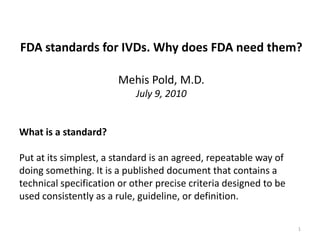Why Does FDA Need Standards For In Vitro Diagnostic Devices
- 1. FDA standards for IVDs. Why does FDA need them? Mehis Pold, M.D. July 9, 2010 What is a standard? Put at its simplest, a standard is an agreed, repeatable way of doing something. It is a published document that contains a technical specification or other precise criteria designed to be used consistently as a rule, guideline, or definition. 1
- 2. The U.S. FDA – The United States Food and Drug Administration Title 21 CFR Part 820 – Title 21 of Code of Federal Regulations, Part 820 • Title 21 describes the rules of FDA • Part 820 contains the quality system regulation (QSR) for medical devices including In Vitro Diagnostic Devices (IVDs). 2
- 3. Part 820 in a nut shell: Design, production, and distribution of medical devices including IVDs must be carried out in a transparently controlled and documented environment by an appropriately trained staff in order to meet the established quality and performance characteristics. 3
- 4. PART 820 QUALITY SYSTEM REGULATION Subpart A -- General Provisions Subpart B -- Quality System Requirements Subpart C -- Design Controls Subpart D --Document Controls Subpart E -- Purchasing Controls Subpart F -- Identification and Traceability Subpart G -- Production and Process Controls equipment. Subpart H -- Acceptance Activities Subpart I-- Nonconforming Product Subpart J -- Corrective and Preventive Action Subpart K -- Labeling and Packaging Control Subpart L -- Handling, Storage, Distribution, and Installation Subpart M -- Records Subpart N -- Servicing Subpart O -- Statistical Techniques 4
- 5. HISTORY of IVD STANDARDS: The Clinical Laboratory Improvement Amendments of 1988: IVDs needed regulations to unify their performance & quality characteristics in order to better serve the public. What is and IVD standard? IVD standard is a published document that contains a technical specification or other precise criteria designed to be used consistently as a rule, guideline, or definition. They are created by bringing together the experience and expertise of all interested parties including the manufacturers, users, and regulators of IVDs. Definition of IVD: IVDs are products that employ reagents, instruments, and systems intended for use in diagnosis of disease or other conditions, including a determination of the state of health, in order to cure, mitigate, treat, or prevent disease or its sequelae. Such products are intended for use in the collection, preparation, and examination of specimens taken from the human body. 5
- 6. What happens if you developed a novel technology for which FDA simply does not have rules? Are you doomed? Certainly not! (1) Time (2) Patience (3) Dialogue Pre-IDE: The "pre-IDE" process is an informal "pre-submission" process. It may involve: sending analytical or clinical protocols to FDA for review and comment before proceeding with studies, or meeting with FDA to discuss protocols and/or possible regulatory pathways. The term "pre-IDE" has been used for this process so that FDA can assign it an official tracking number, just as numbers are assigned to 510(k)s and PMAs. This does not mean that manufacturers are required to subsequently submit an IDE application. 6
- 7. R&D Manufacturing FDA regulatory filing Stable prototype = Fully Full Part 820-compliance established performance possible only if fully established characteristics performance characteristics exist. Otherwise there is nothing to compare the QC results to! Evaluation of Precision Performance of Quantitative Measurement Methods EP05-A2 Evaluation of the Linearity of Quantitative Measurement EP06-A Interference Testing in Clinical Chemistry EP07-A2 Method Comparison and Bias Estimation Using Patient Samples EP09-A2 User Protocol for Evaluation of Qualitative Test Performance EP12-A2 Evaluation of Matrix Effects EP14-A2 7
- 8. FDA values tradition and clarity. Therefore, Title 21 CFR 820 compliance must support clarity. Without the IVD standards, FDA would not know how to properly go about the approval process. The IVD standards equip not only the FDA but also the inventors and manufacturers with useful technical information that promotes the quality of clinical tests. Without the IVD standards, we would be back to the pre-CLIA 88-period that witnessed the deficiencies in laboratory testing due to the lack of clear standards. 8
- 9. Title 21 CFR 820 CONCLUSIONS: Title 21 CFR 820-compliance is essential for successful FDA filing. Full Title 21 CFR 820-compliace is enabled by complete R&D based on IVD standards agreed upon with FDA during pre-IDE. Full 820-compliance is facilitated by pre-IDE process. Especially when IVD stems from novel technology. The U.S. FDA is a partner for IVD companies. 9









